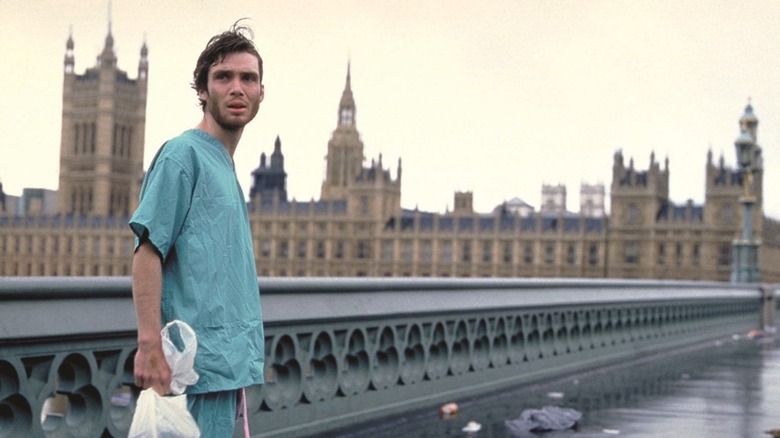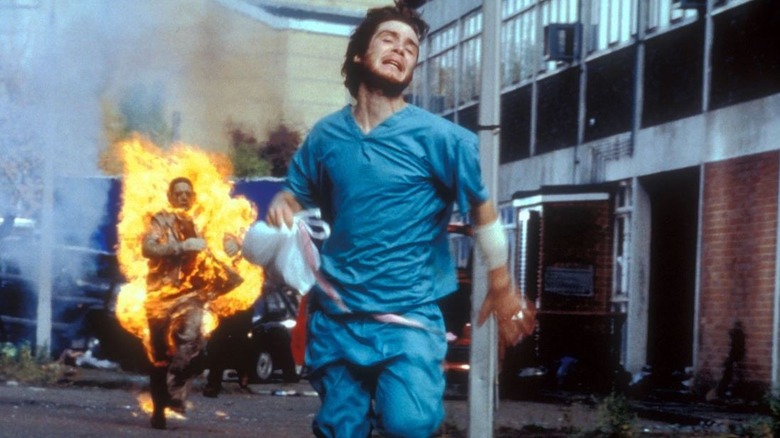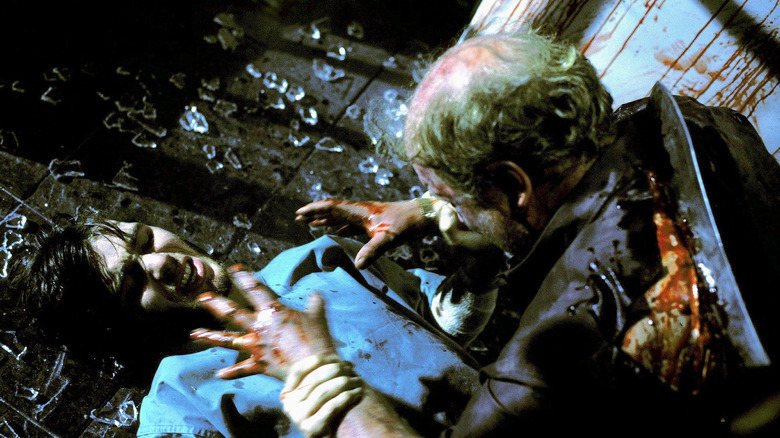Danny Boyle Knew 28 Days Later Was Something Special Without Finishing The Script
20 years have passed and "28 Days Later" still slaps. Directed by Danny Boyle and written by Alex Garland, this low-budget post-apocalyptic British film's timeliness hit home during the bulk of the pandemic. In particular, the oh-so-breathtaking scene with Cillian Murphy's Jim wandering the streets of an abandoned London resonated differently during lockdowns, reminding us of all the thin line between truth and fiction in these apocalyptic scenarios.
A coma patient waking up to a seemingly abandoned world, the audience watches as he attempts to navigate and learn quickly about the new dangers he's woken up to. Rabid infected people are chasing anything living down, with the virus's sole aim to infect and spread. In this environment, you either adapt or die. Eventually, the patient (Jim) finds a group of survivors, who are trying to find a safe haven located in Manchester as advertised in a military broadcast. As they soon discover, the protection comes at too high a cost.
In its simplicity and execution, "28 Days Later" covers a lot of ground without being too distracting. Even though it's fictional, there are still elements of truth woven in that help keep the scenario from feeling farfetched. A huge part of this has to do with the script by Garland, who pulled inspiration from the "Night of the Living Dead" series and the novel, "The Day of the Triffids." The end result was a script so special that Boyle didn't even finish it before he agreed to take it on.
'This is brilliant'
In a recent interview with NME, Boyle looked back in time with Cillian Murphy at "28 Days Later." "I instantly knew the film was something very special," Boyle shared, unearthing memories of the moment when he had started to read the script. "I remember reading the first ten pages of [Alex Garland's script], thinking 'This is brilliant.'" Part of the brilliance was in the visually stunning concept of a completely deserted London which, as mentioned previously, makes for a scene that still dazzles to this day.
"It was like a quarter of a page," he continued, reminiscing about the scene in question before linking it back to our current time's problems. "'He wanders around London on his own' and you just thought 'Oh my God!' What an amazing idea: a deserted London. It's actually come to haunt us [since COVID]. We complain how overcrowded [cities] are and about the stress, and then in an instant, life as we know it in many, many different forms can empty them."
With a limited budget and resources, the team had to come up with a different approach to capturing the haunting visual images from Garland's script. As Boyle shared in an interview with Filmmaker Magazine, they landed on the idea of stillness, which ended up creating those memorable visuals that we all recall when thinking about "28 Days Later." As Boyle and the rest of us would come to learn, those images of stillness would come back to haunt us in the real world 20 years later along with the story's real-world themes on social rage.
'A paranoid story'
While haunting moments sold Boyle on tackling the film, what Boyle and Garland managed to do in the script re-writes helped solidify the unique impact "28 Days Later" had. Thematically, the universal idea of building societal rage that becomes a literal virus is one that resonates, especially in our turbulent sociopolitical times. At the time of release, Garland shared with Filmmaker Magazine the real-world inspirations that were deeply rooted in what was going on in the UK at the time:
"It was just a paranoid story coming out of the paranoid time. Lots of stuff was happening in this country that felt like the right kind of social subtext or social commentary that you could put in a science fiction film. Danny was particularly interested in issues that had to do with social rage — the increase of rage in our society, road rage and other things. Also our government's inability to deal with things like BSE [mad cow disease], Foot and Mouth. You always felt that if a virus exploded into our country, our government would be 20 steps behind wherever the virus was."
If you're having a sense of déjà vu right now, that's okay. I did too when I watched the film last year. Boyle and Garland couldn't predict that a pandemic would rage on years later worldwide. With that said, Garland's script, its social subtext, and the creative thinking Boyle exhibited working around budget constraints to create memorable imagery that came together in a uniquely relatable and frightening film that's stood the test of time. For better or worse.


